|
|
|
|
|
|
|
|
|
|
|
|
|
Growing HEALTHY BOXWOOD |
|
|
|
|
|
Jump to: Choosing Cultivars | Care Overview |Common Problems | Insects | Fungus & Disease | Misc |
|
|
|
|
|
|
|
|
1. Choose the Right Cultivars
|
|
|
|
|
|
The most important aspect in choosing boxwood cultivars is to select the cultivar that best suits your particular application.
This will allow for better long term success of your planting and reduce the amount of care necessary. |
|
|
|
|
|
|
|
|
Jump to: Choosing Cultivars | Care Overview |Common Problems | Insects | Fungus & Disease | Misc |
|
|
|
|
|
|
|
|
2. Plant & Care for them Appropriately
|
|
|
| |
DRAINAGE
- Boxwood do not like wet feet. Amend soil for maximum drainage.
SOIL CONDITIONS
- We are serious about soil. This is the foundation for all plant life and we strive to create conditions where the natural nutrient cycling of the soil is encouraged.
- Before you do anything to your soil you should first get it tested.
- You will want a pH of between 6.5 and 7.2 for boxwood and the soil should be rich
in nutrients & beneficial organisms.
SPACING
- Boxwood have shallow roots. Allow space between plants for root growth and air circulation.
IRRIGATION
- Boxwood do not like long term irrigation, but be sure to water them while they are becoming established and in times of drought.
- Potted boxwood should have irrigation as pots dry out quickly and are more prone to stress.
AIR CIRCLULATION
- Very important for reducing disease potential and maintaining health of plant.
- Make sure there is good air flow around plants,
and that individual plants are pruned to encourage light and air in center of the plant.
MULCH
- Only 1/2 to 1 inch of leaf mulch around your boxwood. Do NOT use bark mulch.
PRUNING & SHEARING
- Do not shear your boxwood,
this encourages leaf growth only at the perimeter of the plant,
which is not enough to sustain the plant long-term.
- Instead you should prune your boxwood to encourage light & air in the center of the plant
FERTILIZERS
Go organic! Synthetic fertilizers only trick the plant into
releasing sugars and putting out more leaf growth, which signals to insects that the plant is weak. Synthetic fertilizers are only good in the short-term. Instead you should use compost & compost tea to improve the health of your boxwood long-term.
PESTICIDES
Again, go organic! Pesticides tend to mask the symptoms, not cure the disease. Instead make sure to follow the cultural practices listed above to prevent disease before it strikes. If you do encounter problems we encourage you to only apply
insecticidal soaps as listed below when needed.
ATTENTION
Boxwood like less attention rather than more. Most cultivars when left on their own tend to do quite well.
|
|
|
|
|
|
|
|
|
|
|
Jump to: Choosing Cultivars | Care Overview |Common Problems | Insects | Fungus & Disease | Misc |
|
|
|
|
|
|
|
|
3. Common problems - Drainage, SOil, Shearing
|
|
|
|
|
|
3A. Poor Drainage
|
|
|
Boxwood do not like wet feet. Below are images of boxwood that show signs of poor drainage.
Amend your soil to ensure proper drainage out and away from the roots. |
|
|
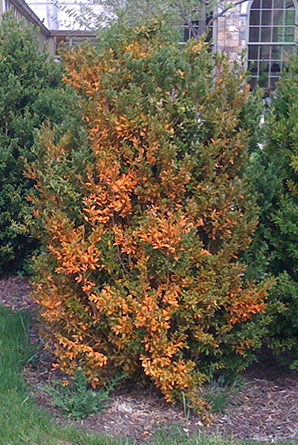 |
|
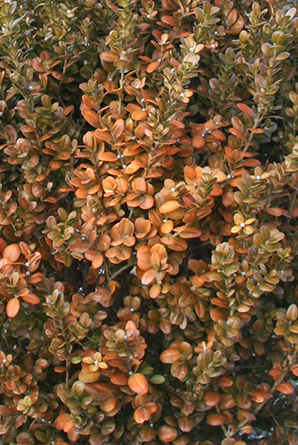 |
|
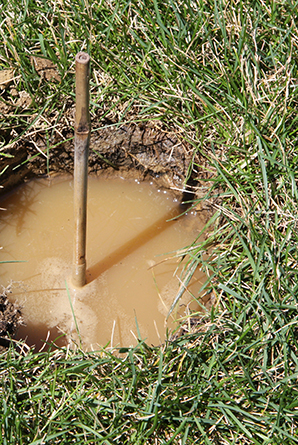 |
| |
|
|
|
Test the permeability of your soil |
|
|
|
|
|
|
|
|
|
|
|
3B. Poor Soil
|
|
|
At F2 Design we put a lot of focus on the soil.
Soil is often overlooked in traditional planting and the focus instead is on adding synthetic nutrients to try to mimic the natural process. At F2 we go back to organic practices and focus on creating a soil environment that fosters the natural nutrient cycle. This results in healthier plants that need fewer inputs of water and nutrients over the long-term. Each environment is different so it is important to first get your soil tested so that you know what you need to add to restore the natural nutrient cycling capacity of the soil.
If you boxwood are looking less than healthy, start with the soil.
|
|
|
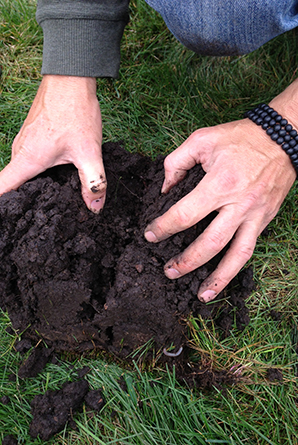 |
|
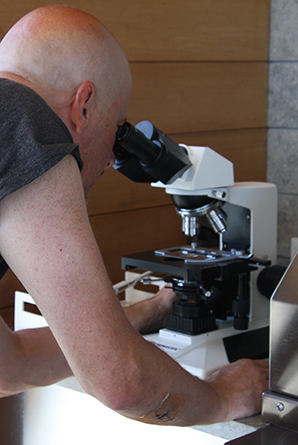 |
|
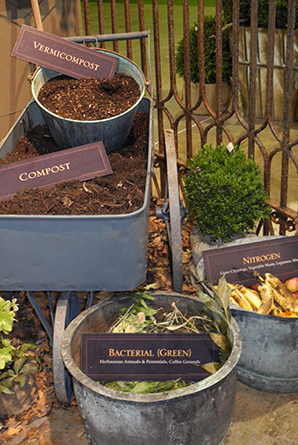 |
| Test your soil |
|
Analyzing the soil biota |
|
Add the necessary components |
|
|
|
|
|
|
|
|
|
|
|
3C. Poor Maintenance
- Shearing
|
|
|
While boxwood that have been sheared can be beautiful, this is a process that leads to poor boxwood health.
If you insist on shearing your boxwood know that you are weakening the plants and will need to replace them regularly.
Why? Shearing creates a dense layer of leaves on the outer edge of the plant that does not let air or light into the center,
which is
the perfect recipe for fungal disease. Also the minimal leaf growth on the perimeter is not enough to sustain the plant.
A sheared plant will have 1/2 inches of growth compared to a properly pruned plant which will have over 2 feet.
Choose cultivars with a natural shape similar to what you are looking for and prune by hand.
Hand Pruning opens up the top and inside of the plant and allows light and air to pass through.
Always trim back to another branch and taper the cut so bottom is wider than the top of the form
|
|
|
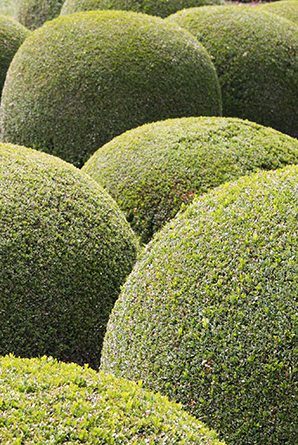 |
|
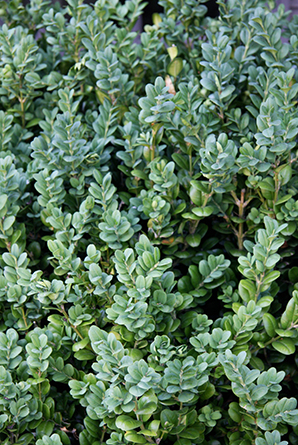 |
|
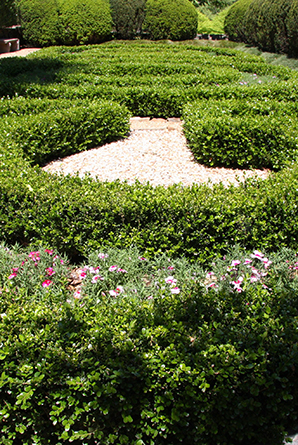 |
| Shearing is beautiful but it leads to poor health |
|
Allow plants to grow naturally |
|
Prune for shape, but allow light into plant |
|
|
|
|
|
|
|
|
|
|
|
Jump to: Choosing Cultivars | Care Overview |Common Problems | Insects | Fungus & Disease | Misc |
|
|
|
|
|
|
|
|
4. INSECTS
|
|
|
The most important factor when dealing with the health of anything prevention. At F2 we strive to create environments that foster plant growth while inhibiting the growth of fungal diseases and pests. This said, there are times when different pests do crop up. |
|
|
|
|
|
4A. Psyllid
|
|
|
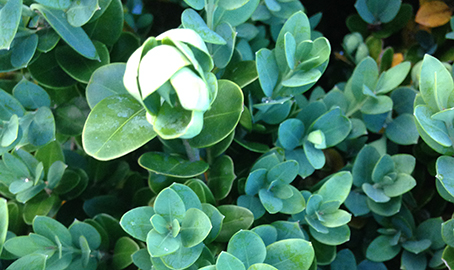 |
|
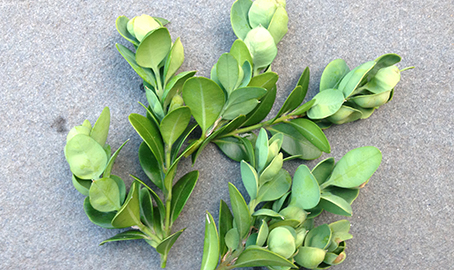 |
Signs of Psyllid, leaves cupping |
|
More signs of Psyllid, with leaves cupping |
|
|
|
|
|
|
Psyllid is a green nymphal insect that consumes the leaf cells causing the leaf to cup
Psyllid Remedy
Early Spring - spray with horticultural oil, getting the bud scales just before the new leaves start to emerge (as bud expands)
Late Spring - spray insecticidal soap when leaves are fully out when you see the white mass on the leaves |
|
|
|
|
|
4B. LEAF MINER
|
|
|
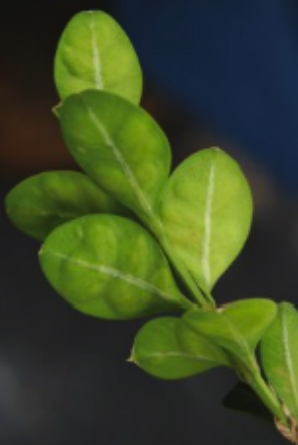 |
|
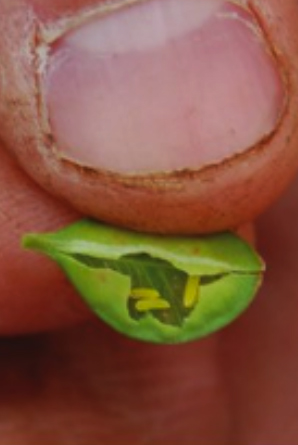 |
|
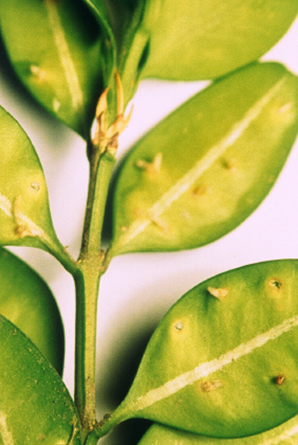 |
Blistered leaf |
|
Larva feeds in leaf |
|
Larva emerges out of the back of the leaf |
|
|
|
|
|
|
|
|
Leaf Miner Remedy
Early Spring - spray with horticultural oil, getting the bud scales just before the new leaves start to emerge (as bud expands)
Late Spring - spray insecticidal soap when leaves are fully out when you see the white mass on the leaves |
|
|
|
|
|
4C. MITES
|
|
|
|
|
|
Mites are a type of spider.
Signs are leaf stippling or light specs, which is more evident on older leaves.
Mites pierce the epidermal cells then suck the juices of the new leaves
Mite Remedy
Spray with horticultural oil in the spring – getting the underside of the leaves where their eggs are.
It is more effective to spray when they are crawling.
|
|
|
4D. BOX TREE MOTH
|
|
|
|
|
|
The Box Tree Moth is an Asian moth that has has been a pest in the UK since 2006. It spread across Europe over the following ten years, reaching Canada in August of 2018. In June of 2021, shipments of infested boxwood reached select retail facilities in the US. As of 2025, the states of Massachusetts and Delaware as well as counties in western New York, southeastern Michigan, southwestern Ohio, and northern Pennsylvania are under quarantines established by APHIS (click here to view the APHIS map).
What to Look For
Box Tree Moth caterpillars are primarily lime-green in color with black heads and intermittent spiky white hairs. They have black and white stripes down their backs with black spots alongside. They grow up to 1.5 inches long. Box Tree Moth caterpillars feed on boxwood leaves and young twigs, causing plant die back. Watch for chewed leaves and bark as well as webbing from the pupa before the caterpillars hatch. Detection is critical as Box Tree Moth caterpillars will only kill boxwood if an infestation goes untreated. Adult moths are primarily active at night and are white with a thick light brown border. Click here for more photos from the USDA.
What do I do if I find Box Tree Moths?
Contact your local Cooperative Extension office or state Department of Agriculture’s plant health section immediately so they can help monitor the spread as well as provide you with the most up to date information on how to control the pest. You may need to provide them with live specimens or photos to ensure proper identification. In addition, The European Boxwood and Topiary Society has a wonderful fact sheet on their website. |
|
|
|
|
|
|
|
|
Jump to: Choosing Cultivars | Care Overview |Common Problems | Insects | Fungus & Disease | Misc |
|
|
|
|
|
|
|
|
5. fungus & disease
|
|
|
Prevention becomes even more important when dealing with fungus and disease as many of them are not curable. Follow the steps mentioned above for proper boxwood care and you should be able to avoid most of theses problems. |
|
|
|
|
|
5A. cylindrocladium 'Boxwood blight'
|
|
|
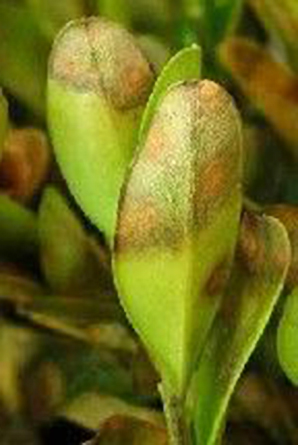 |
|
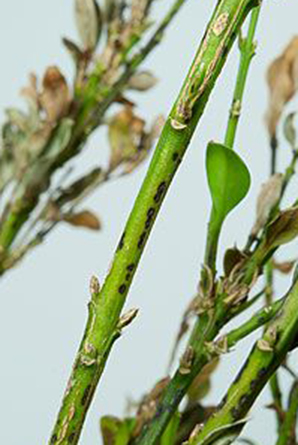 |
|
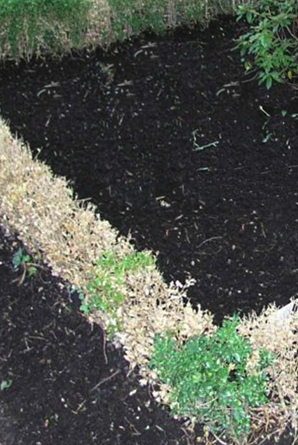 |
| Beginning Stages |
|
Forms brown/black stem cankers & lesions |
|
Planting killed by boxwood blight |
|
|
|
|
|
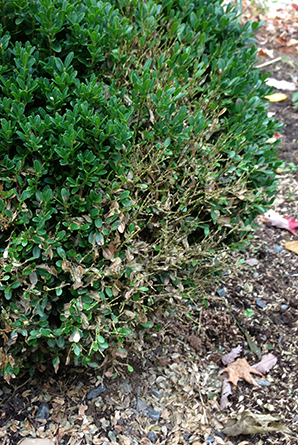 |
|
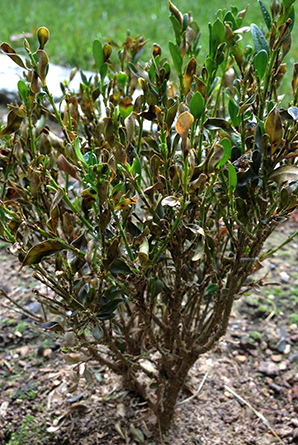 |
|
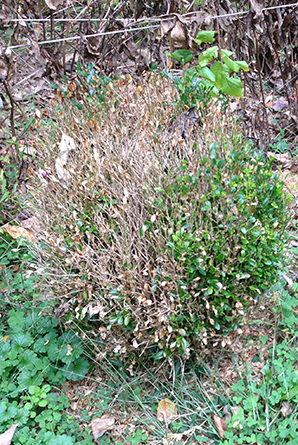 |
| |
|
|
|
|
|
|
|
|
|
|
|
| |
| |
ABOUT
Cylindrocladium buxicola only affects boxwood.
It penetrates the leaf directly through the stomata, which are the holes by which the plant breathes
SYMPTOMS
In the beginning there are small circular leaf spots.
It travels fast – clogging the vascular tissues and clogging the plants arteries
ultimately causing death
CONDITIONS
Cylindrocladium thrives in hot, wet humid conditions
PREVENTION
- There is no known cure for Boxwood Blight so prevention and proper care is key.
- Avoid creating hot, wet, humid conditions where the fungus thrives
- Do not use overhead irrigation, use drip lines only.
- Do not over water
- Keep plants from touching in the nursery
- Prune plants to encourage light and air flow
- Do not shear boxwood
- Keep boxwood at a distance from fountains & water features
- Avoid spreading the disease
- Cylindrocladium is a sticky fungus that can be transplanted on pruners and clothes
- Use a 10% bleach solution to clean all pruners between each cut even when you don't see evidence of the disease
- If you have workers come to your site make sure they follow the best practices to avoid spreading the disease to your site
- If you are working in an area with Cylindrocladium wear a tyvec suit that you dispose of at the end of the job to avoid spreading the disease to other locations
- Plant cultivars that are less susceptible to the disease
- English Boxwood are the most susceptible due to their dense structure.
They are often the canary in the coal mine for Cylindrocladium. If you have English boxwood make sure you prune them to encourage light and air flow in the center of the plant and watch them carefully for signs of the disease.
- All new plantings should be done with varieties that have proved to be more resistant to the disease. We are conducting ongoing research to provide you with the best possible varieties
- We recommend following organic cultural practices to strengthen all plants and help them to keep from being susceptible to this disease.
- Nourish your soil, make sure your plants have good drainage and air flow. In doing so we have been able to avoid Boxwood Blight in the nursery.
- Susceptible plants with good air flow have been shown to remain healthy even when adjacent plants with poor air flow (sheared) have been infected
- Note that pesticides only mask the fungus, do what you can to have robust boxwood that can resist the disease naturally.
TREATMENT
If you have Cylindrocladium, plants with the disease should be dug up and disposed of in garbage bags or burned. Make sure you remove every leaf and it is recommended that you also remove the top 3" of soil as the spores can lay dormant in the soil for up to 7 years. This is critical as each leaf can contain hundreds of fungal spores.
|
|
|
|
|
|
|
|
|
|
|
Jump to: Choosing Cultivars | Care Overview |Common Problems | Insects | Fungus & Disease | Misc |
|
|
|
|
|
|
|
|
6. MISC
|
|
|
|
|
|
DOGS
|
|
|
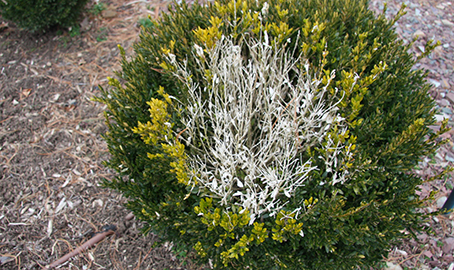 |
|
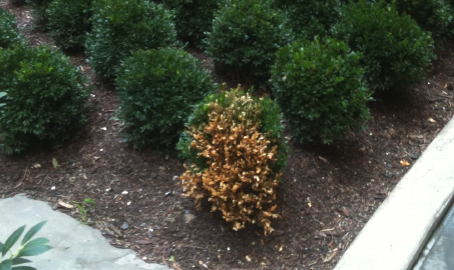 |
| Evidence of Dog Pee on Boxwood |
|
Curb your dog |
|
|
|
|
|
|
|
|
|
|
LINKS TO ADDITIONAL BOXWOOD RESOURCES |
|
|
|
|
|
|
|
|
|
|
|
|
|
|
|



